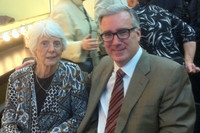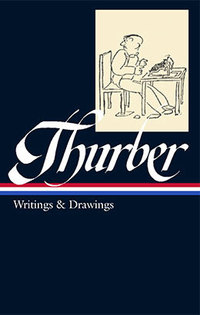
In anticipation of Father’s Day, Keith Olbermann, former host of MSNBC’s Countdown, and Rosemary Thurber, daughter of James Thurber, gathered with friends at the 92nd Street Y Sunday night to honor their fathers by reading from and sharing stories about Thurber’s works. Olbermann recalled that it was about a year and a half ago that he discovered that his readings from James Thurber: Writings and Drawings brought his father, then hospitalized in intensive care, the most pleasure.
“You really should read Thurber on Countdown,” his father recommended. When Olbermann demurred, his father persisted. “How often have I ever suggested anything for your shows? Try it. You never know.”
A few weeks later, his father slipped into a coma but Olbermann continued to read Thurber to him and, one Friday night, he shared his father’s recommendation with Countdown viewers, and read the Thurber fable “The Peacelike Mongoose.” The next day he received an email from Thurber’s agent telling him how much Rosemary Thurber, a regular Countdown viewer, enjoyed his reading.
At last night’s event Rosemary Thurber recounted how Olbermann’s broadcast solved a problem that had been troubling her. A publisher wanted permission to include “The Peacelike Mongoose” in a collection of stories for high school students, but wanted to omit the word “mongoosexual.” Hearing Olbermann read the fable unedited convinced her not to agree to the change. “You gave us the courage to say ‘print it as it is’,” she told Olbermann.

Olbermann’s readings from Thurber became a regular feature of his Friday night broadcast and caused the LOA edition to sell out immediately, leading to two hefty reprints of the book in the past year. Olbermann confirmed that when he launches the new version of Countdown on Current TV on June 20 he will continue to close his Friday night broadcasts with a reading from Thurber.
Rosemary Thurber’s mother didn’t tell her that James Thurber was her father until she was eight. On Sunday she read “The Little Girl and the Wolf,” a fable whose moral is “It is not so easy to fool little girls nowadays as it used to be.” She remembers loving the fable as a little girl: “It was like a great burden lifted from me that there was an adult out there somewhere who knew that little girls weren’t so stupid. And then to find out that it was my father. That was just excellent.” She related that her father created The Last Flower in one night. He dedicated it: “For Rosemary. In the wistful hope that her world will be better than mine.” In 2007 the Iowa University Press published a new edition of the book designed by Thurber’s granddaughter, Sara Thurber Sauers.
Also joining the festivities were New Yorker writer Calvin Trillin and the magazine’s cartoon editor Bob Mankoff. Mankoff noted that “as important as Thurber was to writing, he was more important to cartooning. What he did with brilliant perfection in writing he did with brilliant imperfection in cartooning . . . and he always won his own caption contest.” Mankoff credits Thurber with revolutionizing New Yorker cartoons and opening the magazine up to a new breed of cartoonists.
Thurber’s cartoons are no longer just illustrated anecdotes. They are whole worlds of fantasy that open up many, many possibilities. This style was very liberating for cartoonists. In the interplay of fantasy and reality, many things can happen that can’t happen in reality.
Trillin illustrated Thurber’s lasting legacy at The New Yorker by telling a story about his own rivalry with fellow staffer Thomas Meehan (later author of the book for the musical Annie). They both vied to get more than five “casuals” into the magazine in any one year (what were called “casuals” now appear in the section called “Shouts and Murmurs”). Neither ever succeeded. Years before, Trillin noted, Thurber had placed fifty-one “casuals” in the magazine in one year.



